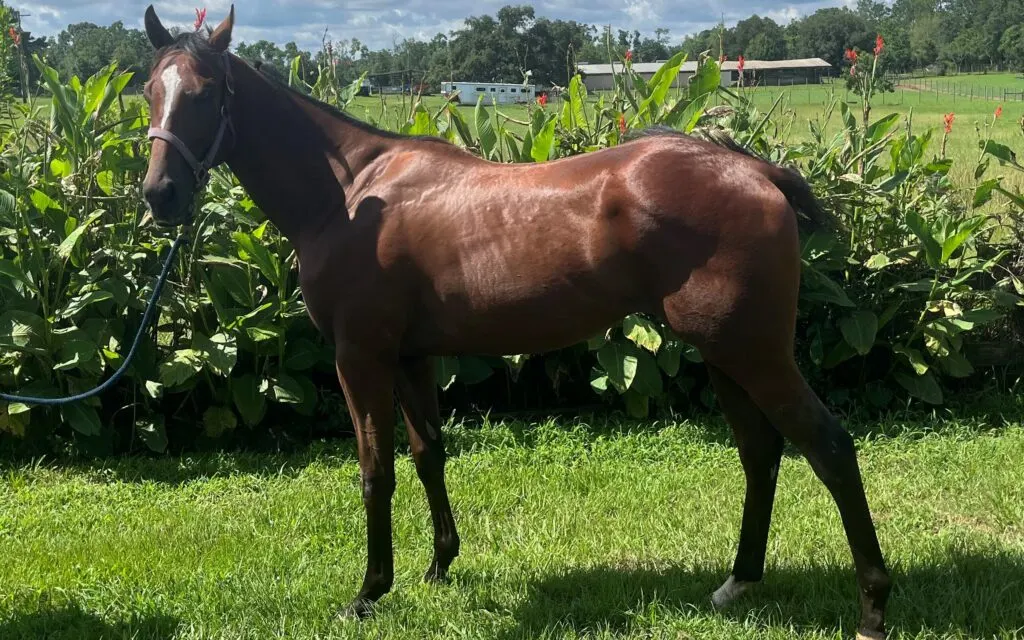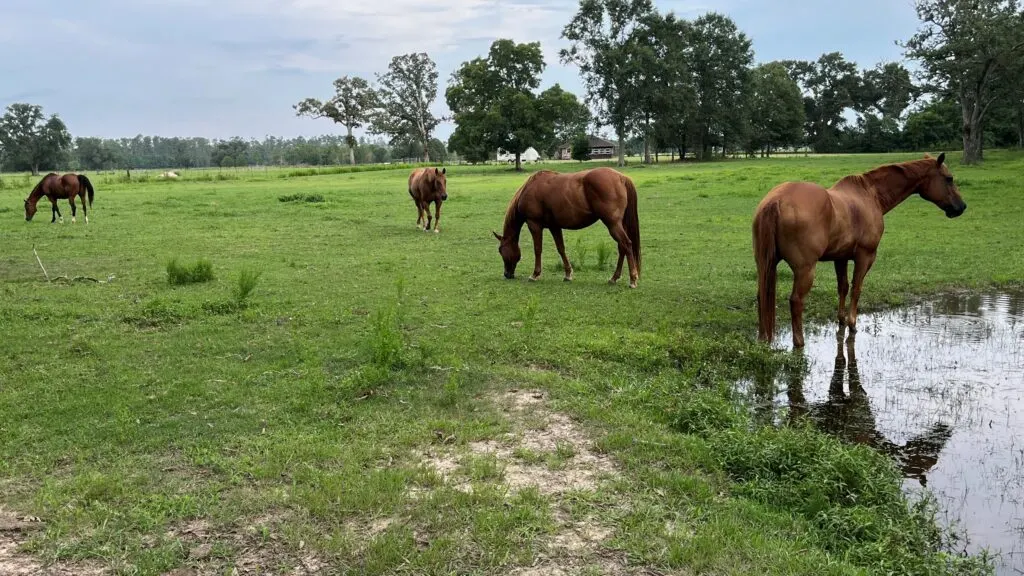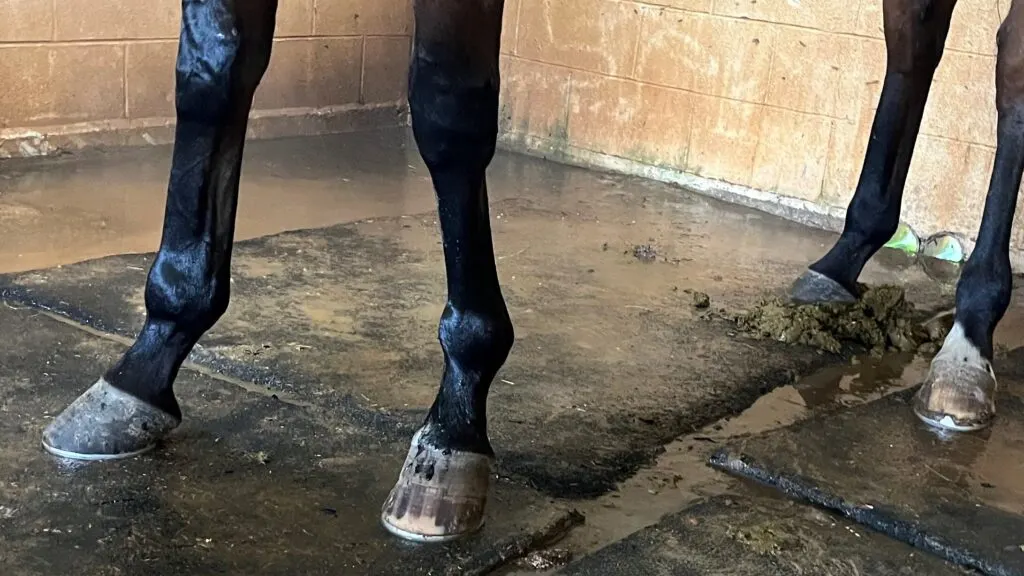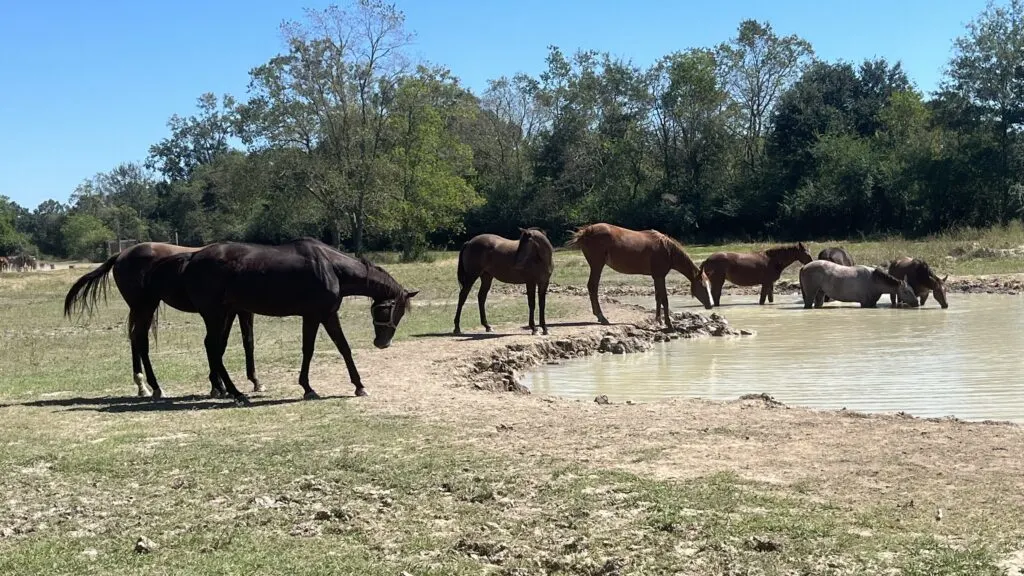Last updated: March 3, 2023
Any links on this page that lead to products on Amazon are affiliate links and I earn a commission if you make a purchase. Thanks in advance – I really appreciate it!
I recently took my grandson to the Bureau of Land Management wild horse sale. He’s seen wild horses before, but I guess with age, he’s become more perceptive. He noticed that the wild horses at the sale didn’t have shoes, yet their feet looked healthy. So he asked me, “why don’t wild horses need shoes?”
Most wild horses don’t need horseshoes for a couple of reasons. First, they have genetically tough, strong, healthy hooves, so they don’t need to protect their feet. Second, wild horses’ hooves are constantly worn down by running and walking on hard surfaces.
In this blog post, we’ll explore the reasons why most wild horses don’t need horseshoes. I’ll also examine whether or not human-kept horses really need to wear shoes. So read on to learn more about why horseshoes are necessary for some horses but not others.
Why wild horses don’t need to wear horseshoes.
The saying “no hoof, no horse” is a common expression in the horse industry that refers to the importance of a horse’s feet in regard to their health. A horse’s hooves are essentially its foundation; without healthy hooves, a horse would not be able to stand, let alone walk or run.
In the wild, horses travel great distances daily, searching for food and water. As a result, their feet need to be strong and durable in order to withstand the rigors of constant travel.

Natural selection
Charles Darwin’s law of natural selection is the process by which organisms adapt to their environment. This process occurs over time, resulting in the survival of the fittest. The law of natural selection is based on the idea that organisms that are better suited to their environment are more likely to survive and reproduce.
Evolutionarily speaking, horses’ hooves have adapted over time to become the strong and durable appendages they are today. Equine fossils found in North America show the evolution of horses’ feet from multi-toe to large, tough hoofs.
In line with Darwin’s Law of “Natural Selection,” horses with stronger feet were more likely to survive and reproduce. Over time, this resulted in a wild horse population with increasingly tough and resilient feet. However, this is not the case for domestic horses.
Domestic horses are selectively bred for performance without regard to hoof health. As a result, their feet are often weak and more susceptible to problems. For example, Thoroughbred racehorses are bred for speed and are exceptionally fast but have notoriously poor feet.
I’ve been around numerous ones with hoof walls so thin and brittle that the farrier couldn’t put horseshoes on them.
Environment
Wild horses live in conditions that are very different from domesticated horses. They roam freely over vast expanses of land, often crossing rough terrain in the process. As a result, their hooves are constantly being worn down and toughened up by the elements.
This strengthens the hooves and helps them to better withstand the rigors of living in the wild. In contrast, domesticated horses often live in stables or in lush pastures, and rarely are they kept in rugged terrain.
As a result, their hooves tend to be softer and more susceptible to injury. That’s why many horse owners opt to have their animals fitted with horseshoes. Horseshoes protect the hooves from wear and tear, and they can also help to correct certain hoof problems.
Below is a YouTube video that shows how wild horse maintain their hooves.
Why horseshoes are not necessary for all horses.
For centuries, horses have been shod with metal horseshoes in an attempt to protect their hooves from wear and tear. However, a growing body of evidence suggests that horses don’t need horseshoes.
In fact, in many cases, horseshoes can do more harm than good. Here’s a look at why some horses may not need horseshoes and why you might want to reconsider them for your own horse.
The Natural Shape of a Horse’s Hoof is Designed for Function
One of the biggest problems with horseshoes is that they often change the natural shape of a horse’s hoof. Wild horses have well-defined concavities on the bottom of their hooves that act like shock absorbers, cushioning their feet as they travel over uneven terrain.
Horseshoes restrict the flexion of their hoof, which can lead to joint problems and other issues later on down the road.

Horses Have Better Hoof Health Without Horseshoes
Another problem with horseshoes is that they often cause more problems than they solve. Many horse owners put their animals in shoes because they think it will strengthen their hooves. However, this isn’t always the case.
In fact, studies have shown that horses who are shod are actually more likely to suffer from hoof problems than those who go barefoot. One of the reasons for this is that shoes prevent the hoof from being able to properly expand and contract as the horse moves around. This can eventually lead to cracks, chips, and other issues.
While it’s true that some domesticated horses do need horseshoes, this isn’t always the case. In fact, many horse owners are now keeping their animals “barefoot” (i.e., without horseshoes).
We never shoe our young horses unless it’s necessary. If they move well and have good feet, we leave them barefoot until they start racing, then we put aluminum racing plates on them. If our horses take a break between competitions, we remove their shoes.
I firmly believe in not keeping shoes on a horse unless they serve a purpose. A lot of horse owners are using horseshoes less. This is because studies have shown that barefoot horses often have healthier hooves than those that are shod.
If you’re considering going barefoot with your horse, be sure to speak with a qualified equine veterinarian or farrier first to assess your horse’s individual needs.

Shoes Can Make It More Difficult for Horses to Move Naturally
Horses are creatures of habit, and once they get used to wearing shoes, they may have difficulty adjusting if they ever need to go without them. This can be a particular problem for wild horses who are captured and then released into new environments without their shoes.
Without shoes, these horses may have difficulty moving about naturally and could even injure themselves in the process. There’s no question that horseshoes have been around for a long time.
But just because something is traditional doesn’t mean it’s still the best way to do things. When it comes to horse care, many experts now believe that less is more.
So, if you’re thinking about horseshoes for your horse, you may want to reconsider. Your horse may be better off without them.

Types of Horseshoes
There are many different types of horseshoes available on the market today. The type that you ultimately choose for your horse will depend on his or her specific needs. For example, if your horse has weak hooves that crack easily, you may want to consider using glue-on shoes instead of traditional nailed-on shoes.
There are many different types of horseshoes available on the market today—and each one has its own advantages and disadvantages. Below is a brief overview of some of the most popular types of horseshoes:
Steel shoes: Steel shoes are by far the most popular type of shoe on the market today—and for good reason. They’re cheap, durable, and easy to find. Under the umbrella of steel shoes, there are many styles, such as rim, bar, heart bar, egg bar, and wedge.
The negatives of steel shoes are that they can be quite heavy—which can put unnecessary strain on your horse’s legs—and they’re not always as flexible as other types of shoes (which can cause problems if your horse stumbles or steps in a hole).
Aluminum shoes: Aluminum shoes are primarily used in horse racing but are becoming increasingly popular for everyday riding due to their being lightweight and flexible. However, they’re also quite expensive—and they don’t always hold up like steel shoes.
Rubber shoes– Rubber shoes are frequently used in show-jumping competitions. They allow flexion of the horse’s hoof and can be either nailed on or glued on, depending on the style and maker.
Plastic shoes: Plastic shoes are designed to mimic the shape and structure of a natural hoof— which is thought to be ideal for optimal hoof health. However, plastic shoes often wear down quickly, requiring frequent replacement.
Alternatives to horseshoes
When it comes to horseshoes, there are a few alternatives that can be used depending on the horse and the situation. The most popular alternative is hoof boots. They are a type of protective footwear that you can slip over a horse’s hoof.
These boots provide protection against rocks, uneven footing, slippery surfaces, etc. There are many different brands and styles available on the market today — so finding one that fits both your and your horse’s needs perfectly may take some trial and error.
However, once you find a boot that works well for you, you may never go back to traditional shoes. Glue-on shoes are another option that can be used instead of traditional horseshoes.
These shoes are glued directly to the hoof, providing a secure fit without needing nails. They are especially helpful when your horse has thin hoof walls. Fiberglass casts are another alternative that can be used in place of horseshoes.
These casts are made from fiberglass and wrap around the horse’s foot. I haven’t used this method because I think if left on for very long, it would weaken a horse’s hoof wall. However, it does provide support and protection.
Hoof wraps are also an alternative to horseshoes. They are primarily used to protect a horse’s foot after an injury during recovery. It can be made from various materials but most often cloth.

Conclusion:
As you can see, there are many factors to consider when deciding whether or not to put horseshoes on your horse. While some horses do benefit from wearing them, others do just fine without them. Ultimately, it’s up to you as the owner to decide what’s best for your animal based on its individual needs and circumstances.
Meet Miles Henry
An avid equestrian and seasoned racehorse owner, Miles Henry brings his extensive experience to the equine world, proudly associating with the AQHA, The Jockey Club, and various other equine organizations. Beyond the racetrack, Miles is an accomplished author, having published various books about horses, and is a recognized authority in the field, with his work cited in multiple publications.
🔗 Connect with Miles:
Twitter
Facebook
YouTube: Check out race highlights, horse care tips, and more!


